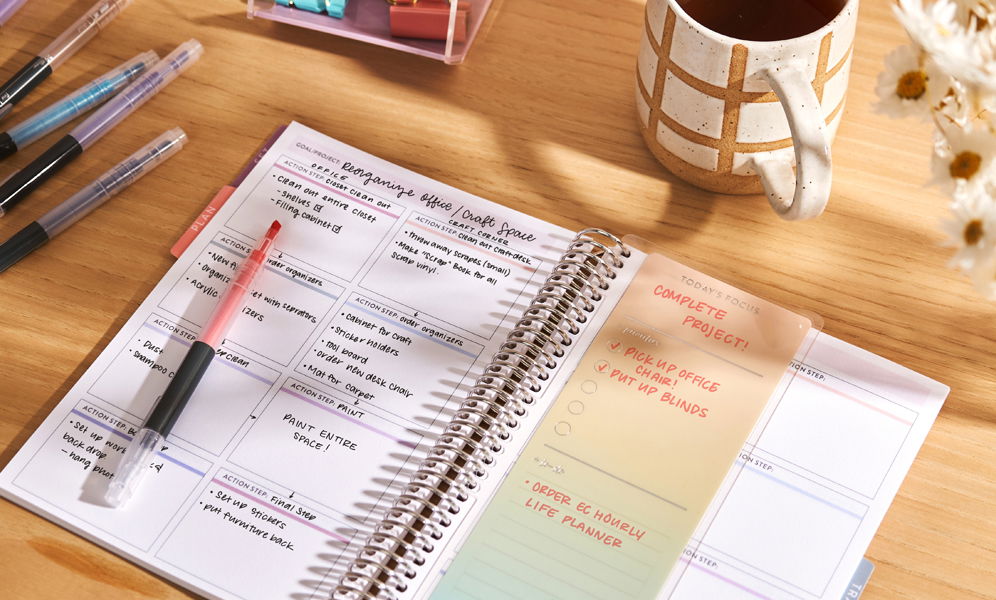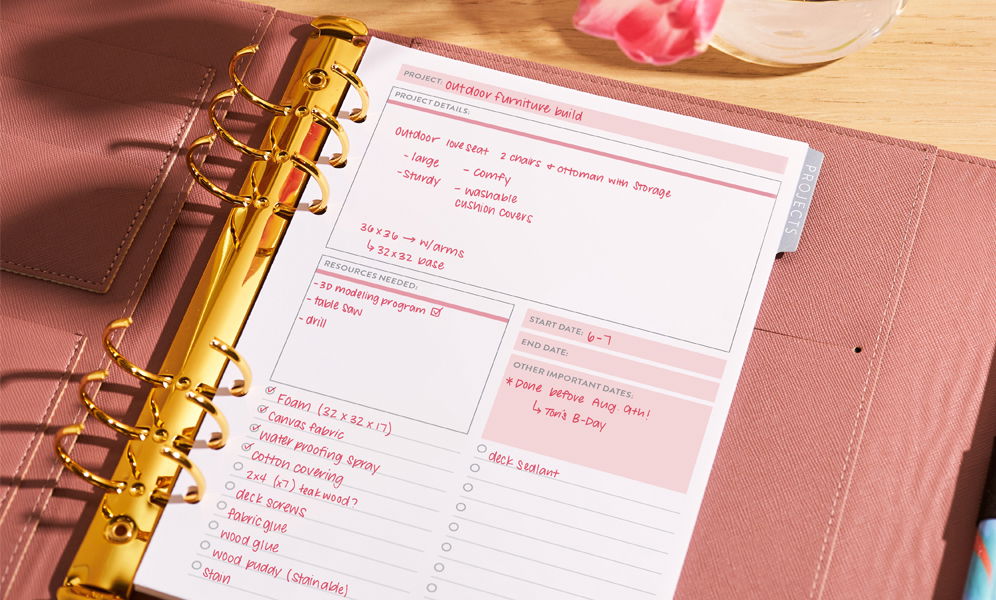Productivity Planning Tips + a Step-by-Step Improvement Plan

Productivity planning – it’s a surprisingly simple practice with powerful, potentially life-changing benefits. Ask yourself: Are you constantly struggling to manage your time and tasks effectively? Do you find yourself overwhelmed by a never-ending to-do list and feel like you're not making progress on your goals? If so, you're not alone. Many people face these challenges in their personal and professional lives. The good news is that with the right approach, you can boost your productivity and achieve more in less time. Let’s get to it and jump right into how you can win at productivity planning, starting with understanding what it is, how it can help you personally, and then we’ll share a simple step-by-step improvement plan to give you a running start.
What Is a Productivity Plan?
Before we delve into the details of productivity planning, it's essential to understand what a productivity plan is. A productivity plan is a structured approach to managing your tasks and time in a way that maximizes your efficiency and helps you reach your goals. It's a guide that helps you through your daily, weekly, and monthly tasks, ensuring that you make the most of your time and resources.
Why Is Productivity Planning Important?
Productivity planning is essential for a variety of reasons. Whether you're a student trying to excel in your studies, a professional aiming to meet deadlines at work, or someone simply looking to make better use of their time, here's why productivity planning matters:
Time Optimization
Time is a finite resource, and once it's gone, you can't get it back. Effective productivity planning helps you stay focused and make the most of your time by focusing on high-priority tasks and minimizing time-wasting activities.
Goal Achievement
Productivity planning aligns your tasks with your goals. It ensures that your daily tasks contribute to your long-term goals, whether they're related to your career, personal development, or health and well-being.
Reduced Stress
A well-organized productivity plan can significantly reduce stress and boost your mental wellness. Knowing what needs to be done and when can alleviate the feeling of being overwhelmed by a never-ending to-do list.
Increased Efficiency
By allocating resources and time wisely, you can complete tasks more efficiently, leaving you with more time for other activities or relaxation. When you complete tasks on time or ahead of schedule, you boost your productivity and build confidence in your skill set.
The Core Concepts of Productivity Planning
Now that you understand the importance of productivity planning, let's tackle the core concepts that build an effective productivity plan.
Understanding Your Goals

The first step in any productivity plan is understanding your goals. What do you want to achieve in the short term and long term? Whether it's acing your exams, completing a project, or improving your health, having clear goals is crucial for effective, strategic planning. Knowing your goals helps you stay focused on what truly matters and avoid distractions.
Prioritizing Tasks
Not all tasks are created equal. Some tasks are more important and urgent than others. The Eisenhower Matrix, a popular productivity tool, categorizes tasks into four quadrants: urgent and important, important but not urgent, urgent but not important, and neither urgent nor important. Prioritizing tasks based on these categories helps you allocate your time and resources effectively.
Allocating Resources
Once you've identified your goals and prioritized your tasks, it's essential to allocate the necessary resources. This includes determining the tools, materials, and people required to complete your tasks successfully. Proper resource allocation ensures that you're well-prepared and can work efficiently.
Time Management
Effective time management is a key element of productivity planning. You must allocate specific time slots for each task and stick to your schedule. This prevents procrastination and helps you make steady progress toward your goals.
5-Step Productivity Improvement Plan

Now that we've covered the fundamental concepts of productivity planning, let's dive into a step-by-step improvement plan that you can start implementing today.
Step 1: Setting Clear Objectives
Begin by defining your objectives. What do you want to accomplish in the short and long term? These objectives will serve as the foundation of your productivity plan. Make sure your goals are specific, measurable, achievable, relevant, and time-bound (SMART).
Step 2: Listing Required Tasks and Organizing by Importance
Once you've established your objectives, make a checklist of all the tasks that need to be completed to achieve them. Next, prioritize these tasks based on their urgency and importance. You can use the Eisenhower Matrix to help with this process. Focus on high-priority tasks that align with your goals.
Step 3: Estimating Time and Resources
Now you’re ready to estimate the time and resources required for each task. You’ll want to be as realistic as possible in your assessments. Understanding how long each task will take and what resources you need will help you create a workable schedule.
Step 4: Writing Out Your Plan
With a clear understanding of your objectives, prioritized tasks, and resource requirements, it's time to create your productivity plan. You can use various tools for planning, including a daily planner, digital calendars, project management software, or a simple notebook. Break your most important tasks into smaller, manageable steps and allocate time slots for each.
Step 5: Monitoring Your Progress

Your productivity plan is by no means a static document. It's a living, dynamic tool that will serve you best if you regularly monitor and adjust it, when necessary. Make it a habit to review your progress and make necessary changes to your daily plan. This could involve re-prioritizing tasks, adjusting time allocations, or adding new tasks as your goals evolve.
The Importance of Productivity Planning in a Group Setting
Productivity planning isn't just something for people working on their own. It becomes even more important when you're part of a team or an organization. In a team, where everyone's efforts come together to make things happen, good productivity planning is like the secret sauce for success. Here’s why it's vital for team members and employees, and how established methods like the Ivy Lee Method can revolutionize group productivity.
Enhancing Team Coordination
Productivity planning ensures that team members are on the same page and understand their roles and responsibilities clearly. A well-structured plan creates a shared vision, aligning everyone toward common goals. This alignment promotes seamless collaboration, reduces misunderstandings, and creates a harmonious working environment within the team.
Maximizing Employee Contribution
For employees, productivity planning empowers them to channel their efforts strategically. It provides a roadmap, enabling individuals to focus on tasks that directly contribute to the team’s objectives. By eliminating ambiguity, employees can concentrate on their strengths, boosting their confidence and overall job satisfaction.
Using the Ivy Lee Method
The Ivy Lee Method encourages employees and teams to prioritize tasks and enhance productivity. Its simplicity lies in its approach: at the end of each workday, team members list the six most important tasks they need to accomplish the following day. The tasks are then prioritized based on their importance. The next day, the team focuses solely on these tasks until they are completed, ensuring that essential objectives are met before addressing less important matters.
Applying the Ivy Lee Method within a team setting instills a sense of discipline and order. Team members collectively decide on their top priorities, ensuring that the team’s energy and time are dedicated to tasks that truly matter. This method encourages a proactive mindset, allowing the team to tackle challenges head-on and achieve consistent progress.
Creating Accountability
Productivity planning is a great way to promote accountability within the team. When tasks and responsibilities are clearly defined, team members are more likely to take ownership of their roles. Regular check-ins and progress reviews, facilitated by the productivity plan, create a sense of responsibility. Team members become accountable not only to themselves but to their colleagues, fostering a culture of reliability and mutual respect.
Improving Team Morale and Satisfaction
A well-organized productivity plan does wonders for team morale. When team members can see the tangible results of their collaborative efforts, it instills a sense of achievement and pride. Accomplishments, even small ones, contribute to a positive work environment (especially when achieved together).
Tips for Effective Productivity Planning
 Below are some practical tips to help you enhance your productivity planning starting today!
Below are some practical tips to help you enhance your productivity planning starting today!
Use a Productivity Planner.
When it comes to enhancing productivity planning, work smarter, not harder – use a dedicated productivity planner (it can be a game-changer). A productivity planner is a purpose-built tool designed to simplify the task of organizing your daily plans, setting and tracking your goals, and adding helpful structure to your tasks. This tool is like your personal assistant, helping you stay on top of your to-do list and aligning your efforts with your objectives.
One of the key benefits of using a productivity planner is the structure it offers. Most productivity planners come with pre-made templates that prompt you to fill in your goals, prioritize tasks, allocate so much time, and even track your progress. The productivity planner eliminates the need to start from scratch, saving you valuable time and ensuring you don't overlook essential elements of your productivity plan.
Productivity planners often feature sections for goal setting. They encourage you to establish SMART (Specific, Measurable, Achievable, Relevant, and Time-bound) goals, which are essential for creating a well-rounded and focused plan. With your goals clearly defined, you can build your daily tasks around achieving them, keeping you on track to reach your long-term goals.
Productivity planners often include sections for reflection and review. Regularly revisiting your productivity planner and tracking your progress can be motivating and help you stay accountable. By identifying which tasks you've successfully completed and which ones need more attention, you can make informed adjustments to your daily plans and better adapt to changing circumstances.
Set Realistic Goals and Timelines.
While it's essential to challenge yourself, it's equally important to set realistic goals and timelines. Setting overly ambitious goals can lead to burnout and disappointment. Be honest with yourself about what you can achieve within a given time frame.
Create Self-Imposed Deadlines.
In addition to external deadlines, set self-imposed deadlines for your tasks. This adds a sense of urgency to your work, helping you stay on track and maintain focus.
Set Aside Time for Breaks.
Don't forget to allocate time for short breaks. Taking regular breaks can boost your productivity by preventing burnout and enhancing your ability to concentrate. The Pomodoro Technique, for example, suggests working for 25 minutes and then taking a 5-minute break.
Productivity planning is a game-changer in achieving your goals and managing your time effectively. By understanding your goals, prioritizing tasks, allocating resources, and practicing good time management, you can boost your efficiency and reduce stress. The step-by-step productivity improvement plan we just discussed can be your roadmap to better productivity.
Remember, it's essential to tailor your productivity plan to your specific needs and goals. What works for one person may not work for another. Experiment with different techniques, tools, and strategies to find the productivity planning approach that suits you best. With practice and commitment, you'll be amazed at how much more you can achieve in your personal and professional life. Explore best-selling productivity tools today and take the first step towards a more productive and fulfilling future.
More Planning and Productivity Guides
You may also enjoy these other popular, guided tips, prompts, and inspiration from our experts for planning, organization, and productivity:
- Mastering Time Management and Productivity: 11 Tips for Success
- How to Set Goals Step by Step: A Roadmap for Success
- 7 Untapped Benefits of Using a Planner for Home and Work
- Science Behind the LifePlanner™ + How It Helps to Stay Organized
- How to Stay Organized at Work: 10 Efficiency Tips
- How to Start Planning: 15 Tips to Start a Planner